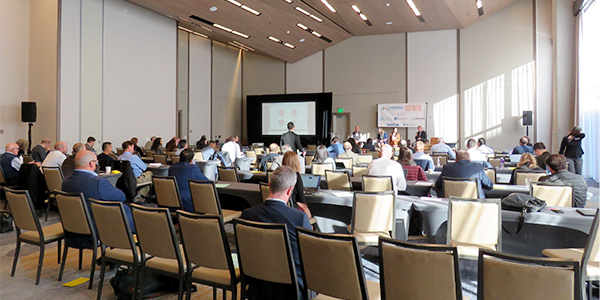By Hudson Sangree
SACRAMENTO, Calif. — A panel of analysts at a renewable energy conference warned that Pacific Gas and Electric could still reject its renewable energy power purchase agreements in bankruptcy despite assurances that it will honor those contracts.
“They may be rejected. They may not. It’s very difficult for us to tell,” Terry Pratt, energy and industrials director with Fitch Ratings, told the audience at Infocast’s CA Renewable Procurement Summit 2.0.
PG&E’s equipment has come under suspicion for starting the Kincade Fire on Oct. 23, and the utility intentionally blacked out more than 2 million residents twice in recent weeks as part of its public safety power shutoff (PSPS) program. The company’s stock sank briefly to a record low of less than $4/share on Monday. (See PG&E Stock Plummets amid Wildfires.)
Those factors only add uncertainty to what PG&E might do during its Chapter 11 reorganization in the U.S. Bankruptcy Court in San Francisco, analysts said. The company filed for bankruptcy protection in January following two years of devastating wildfires.
“Any [renewable energy] project that has a PG&E offtake is not getting paid when PG&E turns the electricity off,” Pratt said.
Helen Kou, decentralized energy analyst with Bloomberg NEF, said clients ask the research firm whether PG&E can or should renege on its PPAs, many of which were signed when wind and solar power cost far more than today’s market prices. Experts interviewed by Bloomberg, she said, have differing opinions.
One audience member asked why it would benefit PG&E to reject above-market-rate PPAs, as PG&E passes on the cost of those contracts to ratepayers.
Anne Selting, analytical manager with S&P Global Infrastructure Ratings, said the company will likely have to layer on wildfire costs to its electricity rates post-bankruptcy, and it can only increase its rates so much before the situation becomes unworkable. Trimming its PPA costs would help the utility going forward, she said.
The possibility that PG&E could reject its contracts for renewable energy or stop paying has put projects at risk that primarily serve the utility, Selting said.
Projects are typically heavily leveraged with debt, she explained. Lenders will often provide loans up to a 90% loan-to-project-value ratio with the understanding that dependable payments from utilities such as PG&E will make sure debt gets serviced, she said.
With PG&E in bankruptcy, and facing new threats to its solvency, there’s less assurance that it will honor its contracts, Selting said.
That’s why Topaz Solar Farm, one of the nation’s largest solar projects, saw its credit rating tumble after PG&E filed for bankruptcy, even though the utility hasn’t missed any payments to Topaz, she said. The solar array in San Luis Obispo County is owned by Berkshire Hathaway Energy. PG&E is the sole offtaker of Topaz’s solar production.
In comparison to today’s wildfire crisis, the Western Energy Crisis of 2000-2001 was relatively straightforward, Selting said. Then, Enron and others took advantage of flaws in California’s electricity deregulation scheme, but policymakers soon figured out long-term fixes.
In contrast, PG&E’s new chairman, Bill Johnson, said at a press conference earlier this month that PSPS could continue for a decade as the utility hardens its grid. That’s quite different and far more uncertain, Selting said. (See PG&E Says Blackouts Will Continue.)
“We have very little control over where we’re heading,” she said. “The ability to respond quickly and fix the problem doesn’t exist.
“We really are at a moment, where I think, at least for California, the risks are being recalibrated,” Selting said. “And I don’t think anyone in this room knows what that means.”





